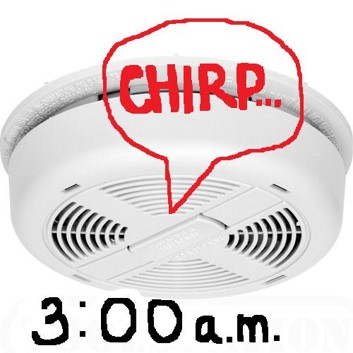
When an apartment building or condominium is built or renovated, an option overlooked by many designers of record is using a system detector instead of a single station smoke alarm in the dwelling units. As with many choices, cost is usually a primary concern. However, the overall cost of the choice is only one consideration when deciding upon dwelling unit life safety options. We’ll explore the differences between the two in order to help a designer decide which is more cost effective in the long run. This could be a long article, so we’ll break it up into a series of blogs so the information is more referenceable.
The first difference is the terminology. Single station devices are referred to as ‘smoke alarms‘, while fire alarm connected devices are referred to as ‘smoke detectors‘. I know they’re all generally referred to as detectors, but when one is writing or speaking in a legally binding manner, using the correct terminology can be the difference between a major change order and a clear scope of work.
Now let’s define the devices and the differences between them. Single/multiple station smoke alarms are the kind you would buy for your house, except that they’re required to be powered by 120 vac or 24 vdc in multi-residential occupancies instead of by batteries. Multiple station smoke alarms, which should also be used in a multi-residential application, have the ability to be interconnected so that if one goes off, the others will sound as well. Models combining smoke detection with carbon monoxide detection are available, as well as models with auxiliary contacts that can control an additional action. Some models have an isolated heat detector that can be monitored by a fire alarm system. Smoke alarms are manufactured to meet UL 217 standards, which have been recently updated (but not mandated until 07/21) to be much more resistant to false alarms caused by cooking. Burning your food will still set it off, though.
One important note: single/multiple station smoke alarms do not have low frequency sounders as called for in some cases per NFPA 72 and ADA standards. Lower frequencies are heard better by older people & those that are hearing impaired. You will find some models advertising multiple frequency sounders, which is better than a single frequency, but they are not low frequency. Low frequency requires a speaker, which won’t fit onto a single station PC board.
System smoke detectors are connected to fire alarm systems via a supervised, low voltage circuit, usually a data signaling line circuit (SLC). They are almost always a separate detector head that twists into base unit. The detector base unit is capable of providing a low frequency sounder, as well as auxiliary contacts for additional control, such as closing a door. The detector head also have combination models, including carbon monoxide and/or heat detectors. For multi-sensor models, each sensor can be programmed to provide a separate output. The smoke detector can also be programmed to function as a single station alarm, providing a non-evacuation signal to the system for recordkeeping purposes, activating its individual sounder and self-restoring. The sounder in the base can be programmed to activate upon any system activity, providing general alarm audibility in the dwelling units. System smoke detectors are manufactured under UL 268 standards, which, again, was updated but won’t be mandated until July 2021. The new standard make detectors more sensitive to polyurethane flaming and smoldering, as well as more resistant false alarms caused by cooking. All Gamewell-FCI system detectors are currently being manufactured to meet the new UL 268 standard .
Our next blog will cover installation requirements for single station and system devices. In the meantime, contact Affiliated Fire Systems for more information about installing the proper device in any situation using industry leading Honeywell’s Gamewell-FCI life safety equipment.
Gene Rowe, SET NICET IV, Fire Alarm Systems Affiliated Fire Systems Downers Grove, IL


Send us a Comment